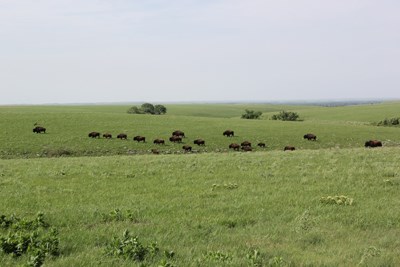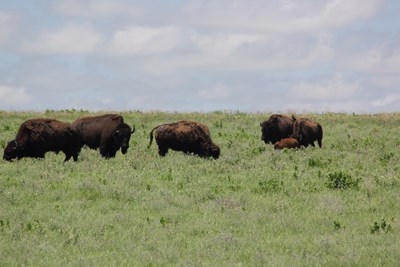Last updated: November 6, 2017
Article
Bison Bellows: Tallgrass Prairie National Preserve

NPS Photo/Kristen Hase
In 1996, the Tallgrass Prairie National Preserve was established in east-central Kansas to protect almost 11,000 acres of the once immense tallgrass prairie that once stretched across central North America. Of the approximately 400,000 square mile of tallgrass prairie that existed in the 19th century, less than 4% remains, largely in the Flint Hills of Kansas. The preserve is a unique partnership between The Nature Conservancy (TNC) and the National Park Service (NPS), each working together to preserve this high quality native tallgrass prairie remnant.
The Preserve is co-managed as a public-private preserve, with NPS owning roughly 33 acres of the preserve, and TNC owning the rest. Together, the NPS and TNC work to protect a culturally significant landmark that includes a historical ranch house, limestone barn, and schoolhouse, as well as the unique natural resources of the preserve, including a bison herd of roughly 90 animals! After a century and a half absence of bison, NPS and TNC restored 13 bison to the preserve in 2009 from Wind Cave National Park. This restoration of bison not only represented a vital component for the tallgrass prairie ecosystem, but also conservation of the American bison.

NPS Photo/Kristen Hase
Tallgrass Prairie National Preserve chose Wind Cave National Park as a source for bison based on the herd's high genetic diversity, apparent absence of cattle genes, and disease free status. In addition, the Tallgrass Prairie National Preserve herd helps Wind Cave National Park by increasing Wind Cave's effective population size of bison. In accordance with the Department of Interior Bison Conservation Initiative, managers recommend that conservation herds need approximately 1,000 individuals to maintain genetic diversity. However, with today's increasingly fragmented landscape, it is extremely difficult to have 1,000 individuals in every herd. Therefore, smaller satellite herds can contribute to these larger conservation herds. To accomplish this goal, Wind Cave National Park represents a large source herd that helps establish new bison herds in other states, Tallgrass Prairie National Preserve being one of these satellite herds. TNC also has other preserves with Wind Cave bison that also serve as satellite populations. In the future, more bison may come from Wind Cave National Park to help maintain the genetic integrity of Tallgrass Prairie National Preserve bison.
Tallgrass Prairie National Reserve plays an important role in preserving a high quality remnant of tallgrass prairie natural and cultural resources, helps preserve the genetic integrity of the bison, and provides a home to unique tallgrass biodiversity.
